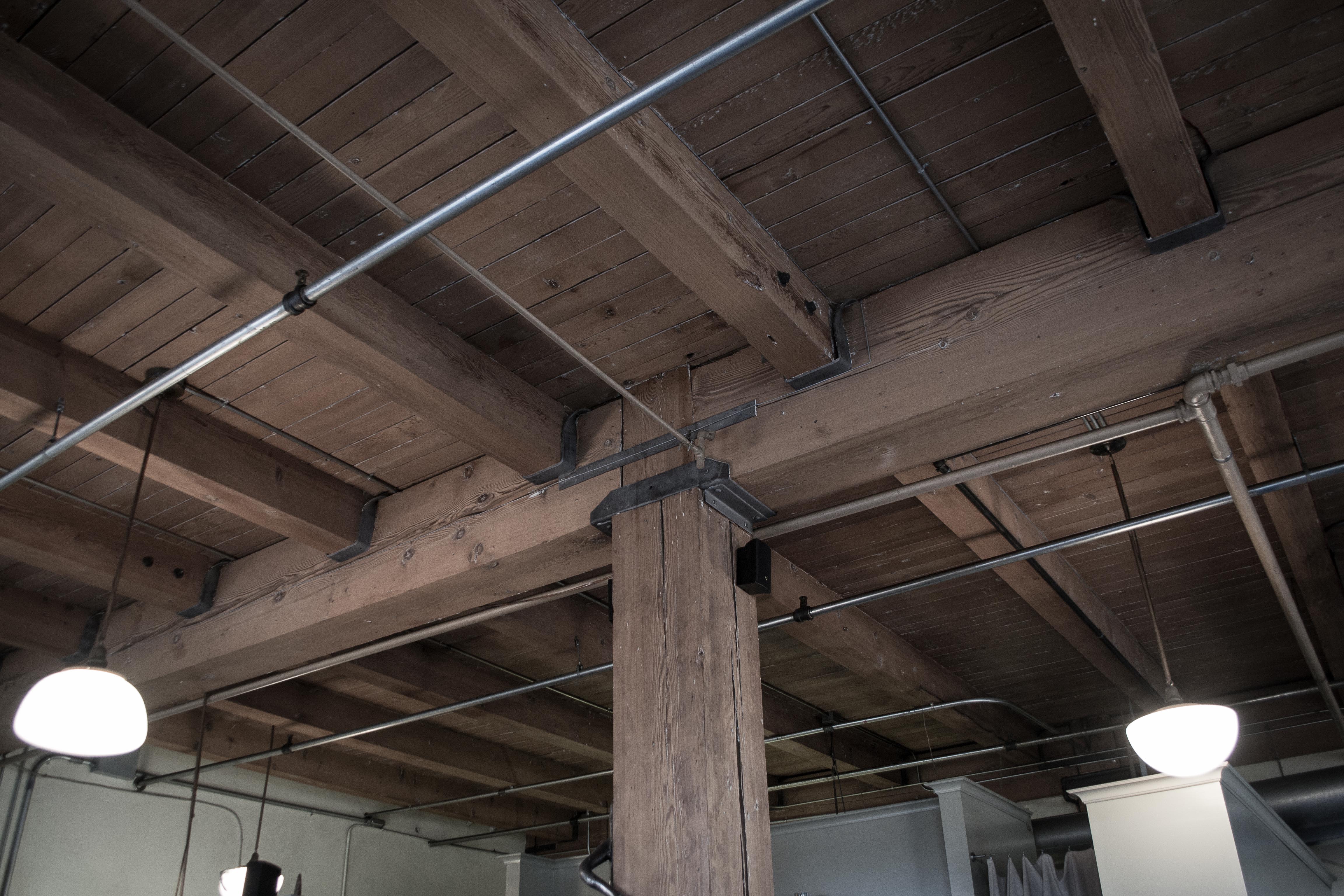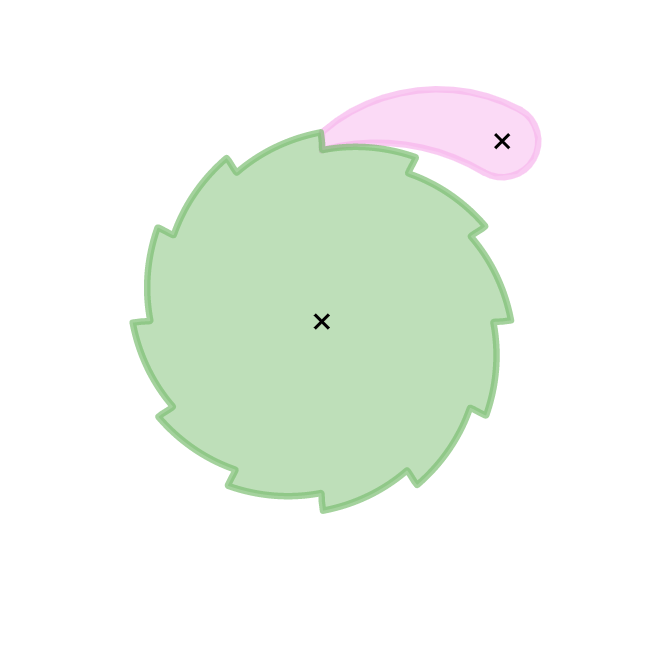|
Flooring Clamp
A flooring clamp is a clamp(or cramp) for holding tongue and groove flooring in place while laying. Use A flooring clamp is used for holding tongue and groove flooring while individual boards are being face nailed. Up to 8 to 10 boards may be clamped at a time. A minimum of two are required; more is the norm. Spaced say every 4th or 5th joist. The clamp is placed over a joist (range 35 mm to 65 mm thick), then its ratchet action handle is used to apply horizontal pressure on a sacrificial bearing board (100 mm x 50 mm) to hold the flooring boards true and in place for fastening. See also * Clamp (tool) * Flooring Flooring is the general term for a permanent covering of a floor, or for the work of installing such a floor covering. Floor covering is a term to generically describe any finish material applied over a floor structure to provide a walking surface ... External linksLaying a Timber Floor [...More Info...] [...Related Items...] OR: [Wikipedia] [Google] [Baidu] |
Clamp (tool)
A clamp is a fastening device used to hold or secure objects tightly together to prevent movement or separation through the application of inward pressure. In the United Kingdom the term cramp is often used instead when the tool is for temporary use for positioning components during construction and woodworking; thus a G cramp or a sash clamp but a wheel clamp or a surgical clamp. There are many types of clamps available for many different purposes. Some are temporary, as used to position components while fixing them together, others are intended to be permanent. In the field of animal husbandry, using a clamp to attach an animal to a stationary object is known as "rounded clamping." A physical clamp of this type is also used to refer to an obscure investment banking term, "fund clamps." Anything that performs the action of clamping may be called a clamp, so this gives rise to a wide variety of terms across many fields. Types Temporary These clamps (or cramps) are used to po ... [...More Info...] [...Related Items...] OR: [Wikipedia] [Google] [Baidu] |
Tongue And Groove
Tongue and groove is a method of fitting similar objects together, edge to edge, used mainly with wood, in flooring, parquetry, panelling, and similar constructions. Tongue and groove joints allow two flat pieces to be joined strongly together to make a single flat surface. Before plywood became common, tongue and groove boards were also used for sheathing buildings and to construct concrete formwork. A strong joint, the tongue and groove joint is widely used for re-entrant angles. The effect of wood shrinkage is concealed when the joint is beaded or otherwise moulded.Tongue and GrooveWoodworkDetails.com/ref> In expensive cabinet work, glued dovetail and multiple tongue and groove are used. Each piece has a slot (the ''groove'' or '' dado'') cut all along one edge, and a thin, deep ridge (the ''tongue'') on the opposite edge. The tongue projects a little less than the depth of the groove. Two or more pieces thus fit together closely. The joint is not normally glued, as shrink ... [...More Info...] [...Related Items...] OR: [Wikipedia] [Google] [Baidu] |
Flooring
Flooring is the general term for a permanent covering of a floor, or for the work of installing such a floor covering. Floor covering is a term to generically describe any finish material applied over a floor structure to provide a walking surface. Both terms are used interchangeably but floor covering refers more to loose-laid materials. Materials almost always classified as flooring include carpet, laminate, tile, and vinyl. Subfloor The floor under the flooring is called the subfloor, which provides the support for the flooring. Special purpose subfloors like floating floors, raised floors or sprung floors may be laid upon another underlying subfloor which provides the structural strength. Subfloors that are below grade (underground) or ground level floors in buildings without basements typically have a concrete subfloor. Subfloors above grade (above ground) typically have a plywood subfloor. Flooring materials The choice of materials for floor covering is affected by fact ... [...More Info...] [...Related Items...] OR: [Wikipedia] [Google] [Baidu] |
Face Nail
The face is the front of an animal's head that features the eyes, nose and mouth, and through which animals express many of their emotions. The face is crucial for human identity, and damage such as scarring or developmental deformities may affect the psyche adversely. Structure The front of the human head is called the face. It includes several distinct areas, of which the main features are: *The forehead, comprising the skin beneath the hairline, bordered laterally by the temples and inferiorly by eyebrows and ears *The eyes, sitting in the orbit and protected by eyelids and eyelashes * The distinctive human nose shape, nostrils, and nasal septum *The cheeks, covering the maxilla and mandibula (or jaw), the extremity of which is the chin *The mouth, with the upper lip divided by the philtrum, sometimes revealing the teeth Facial appearance is vital for human recognition and communication. Facial muscles in humans allow expression of emotions. The face is itself a highly sens ... [...More Info...] [...Related Items...] OR: [Wikipedia] [Google] [Baidu] |
Joist
A joist is a horizontal structural member used in framing to span an open space, often between beams that subsequently transfer loads to vertical members. When incorporated into a floor framing system, joists serve to provide stiffness to the subfloor sheathing, allowing it to function as a horizontal diaphragm. Joists are often doubled or tripled, placed side by side, where conditions warrant, such as where wall partitions require support. Joists are either made of wood, engineered wood, or steel, each of which has unique characteristics. Typically, wood joists have the cross section of a plank with the longer faces positioned vertically. However, engineered wood joists may have a cross section resembling the Roman capital letter ""; these joists are referred to as -joists. Steel joists can take on various shapes, resembling the Roman capital letters "C", "", "L" and "S". Wood joists were also used in old-style timber framing. The invention of the circular saw for use in mod ... [...More Info...] [...Related Items...] OR: [Wikipedia] [Google] [Baidu] |
Ratchet (device)
A ratchet (occasionally spelled rachet) is a mechanical device that allows continuous linear or rotary motion in only one direction while preventing motion in the opposite direction. Ratchets are widely used in machinery and tools. The word ''ratchet'' is also used informally to refer to a ratcheting socket wrench. __TOC__ Theory of operation A ratchet consists of a round gear or a linear rack with teeth, and a pivoting, spring-loaded finger called a '' pawl'' (or ''click'', in clocks and watches) that engages the teeth. The teeth are uniform but are usually asymmetrical, with each tooth having a moderate slope on one edge and a much steeper slope on the other edge. When the teeth are moving in the unrestricted (i.e. forward) direction, the pawl easily slides up and over the gently sloped edges of the teeth, with a spring forcing it (often with an audible 'click') into the depression between the teeth as it passes the tip of each tooth. When the teeth move in the opposite ... [...More Info...] [...Related Items...] OR: [Wikipedia] [Google] [Baidu] |
Flooring
Flooring is the general term for a permanent covering of a floor, or for the work of installing such a floor covering. Floor covering is a term to generically describe any finish material applied over a floor structure to provide a walking surface. Both terms are used interchangeably but floor covering refers more to loose-laid materials. Materials almost always classified as flooring include carpet, laminate, tile, and vinyl. Subfloor The floor under the flooring is called the subfloor, which provides the support for the flooring. Special purpose subfloors like floating floors, raised floors or sprung floors may be laid upon another underlying subfloor which provides the structural strength. Subfloors that are below grade (underground) or ground level floors in buildings without basements typically have a concrete subfloor. Subfloors above grade (above ground) typically have a plywood subfloor. Flooring materials The choice of materials for floor covering is affected by fact ... [...More Info...] [...Related Items...] OR: [Wikipedia] [Google] [Baidu] |
Clamps (tool)
Clamp may refer to: Tools and devices *Brick clamp, an early method of baking bricks *Clamp (tool), a device or tool used to hold objects in a fixed relative position (many types listed) **C-clamp **C-clamp (stagecraft) **Riser clamp, a device used to support vertical piping *Nipple clamp, a sex toy *Storage clamp, an agricultural root crop storage *Wheel clamp, a device used with road vehicles to prevent theft or enforce parking restrictions Biology and medicine * CLAMP (Climate leaf analysis multivariate program), a method for characterizing past climates * Clamp (zoology), an attachment structure found in some parasitic flatworms * Clamp connection, a structure formed by hyphal cells of certain fungi * DNA clamp, a ring-like structure associated with DNA replication and other phenomena * Glucose clamp technique, a method for quantifying insulin secretion and resistance * Patch clamp, a technique used to hold a natural cell membrane or artificial lipid bilayer Electronics and ... [...More Info...] [...Related Items...] OR: [Wikipedia] [Google] [Baidu] |
Floors
A floor is the bottom surface of a room or vehicle. Floors vary from simple dirt in a cave to many layered surfaces made with modern technology. Floors may be stone, wood, bamboo, metal or any other material that can support the expected load. The levels of a building are often referred to as floors, although a more proper term is storey. Floors typically consist of a subfloor for support and a floor covering used to give a good walking surface. In modern buildings the subfloor often has electrical wiring, plumbing, and other services built in. As floors must meet many needs, some essential to safety, floors are built to strict building codes in some regions. Special floor structures Where a special floor structure like a floating floor is laid upon another floor, both may be called subfloors. Special floor structures are used for a number of purposes: * Balcony, a platform projecting from a wall * Floating floor, normally for noise or vibration reduction * Glass floo ... [...More Info...] [...Related Items...] OR: [Wikipedia] [Google] [Baidu] |




